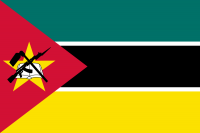Mozambique

Mozambique lies on the east coast of Southern Africa, measuring a total of some 799,380 km² in area. The country borders the United Republic of Tanzania, Zambia, Malawi, Zimbabwe, South Africa and Swaziland. The country’s extensive coastline stretches 2,515 km along the south east and east coast of Africa. The Zambezi and Limpopo rivers, two of Africa’s major rivers, flow through Mozambique to the Indian Ocean. There are a number of islands on the coast including the Quirimba Archipelago in the region of Cabo Delgado, Mozambique Island in Nampula province, Chiloane Island in Sofala, the Bazaruto Archipelago in Inhambane and Inhaca Island in Maputo province.
The climate varies from subtropical to tropical (south to north) and is influenced by the monsoons of the Indian Ocean and by the warm current of the Mozambique Channel. Temperatures range from 13 to 24 degrees Celsius during the dry season, which is May to September, and from 22 to 31 degrees Celsius during the wet season, namely October to April. The central and southern provinces are prone to severe drought, devastating cyclones and floods.
The total population is approximately 20,579,265 (latest census). There are many different ethnic groups in Mozambique, the largest being the Makua-Lomwe, which accounts for around 40 % of the population, with others including the Shona and the Tsonga. The official and business language is Portuguese. English is widely spoken in business and academic circles, especially in Maputo. Local languages include Emakua, Shangane, Bitanga, Xitswa, Chope, Ronga, Elomwe, Chuabo, Sena, Shona, Ndau, Nyandja, Kimwani and Chimakonde. Maputo is the capital of Mozambique, and other major population centres includes Beira, the second largest city, which also acts as the business and transport hub for the central region of the country. Mozambique became independent on 25 June, 1975 and the first multi-party elections were held in 1994, and the president is the Head of State.
Agriculture is the backbone of the economy providing employment for over 75 % of the workforce and contributing an estimated 26.2 % to Gross Domestic Product (GDP) in 2005. The cash and export crops include sugarcane, cotton, tea and tobacco. The fisheries sector is also another major source of foreign exchange earnings, accounting for around 2 % of the GDP in 2004. Mozambique’s industrial sector has main manufacturing operations including light engineering, food industries, textiles, brewing, soft drinks, cement, oils, soaps and chemicals. The industrial sector’s contribution to GDP in 2005 was estimated at 34.8 %.
Mozambique has several tourist attraction areas such as the 2,515 km of Indian Ocean coastline dotted with sandy beaches and clear water, colonial hotels, an abundance of some of the world’s most exquisite seafood, as well as an interior with beautiful scenery and wildlife. Beach tourism has expanded along the southern coast, including the islands of the environmentally unique Bazaruto Archipelago in Inhambane province. Other major tourist attractions include the Ibo Islands and the city of Pemba in the north of the country. Mozambique Island, also in the north, is a major historical and cultural attraction reflecting indigenous African culture and architecture as well as Arab and Portuguese influences.

